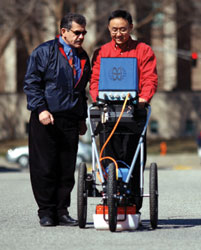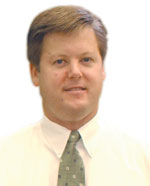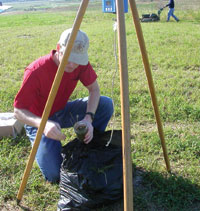![]() Current Issue
Current Issue
(Fall 2005)
All the Fixin's
The Center for Infrastructure Research Studies the Causes of Crumbling Roads, Pipes and More
Acts of terror, freak blackouts, earthquakes, giant sinkholes that swallow cars whole ...
These dramatic events are legitimate concerns to utilities and others charged with protecting and maintaining the nation’s infrastructure.

J.P. Mohsen (left) and doctoral student Zhiyong Zhao “road test” radar-on-wheels to detect underground infrastructure dangers.
Yet costlier damage to roads, pipes and electrical lines can be blamed on more mundane events that don’t get headlines—such as weather, erosion and heavy traffic. Or even disinfectants.
In disinfecting their systems, for instance, some water utilities are switching from pure chlorine to chloramines that are believed to be less harmful to health. But the ammonia that’s part of the new treatment can be harsh to rubber components in the pipes.
“Parts that used to last 10 years are lasting just six months in some locations,” says Tom Rockaway, director of the Center for Infrastructure Research in the J.B. Speed School of Engineering’s department of civil and environmental engineering (CEE).
With funding from the American Water Works Association Research Foundation (AwwaRF), the center is studying why the damage is occurring and how utilities can prevent and fix it.
The research project is one of several under way at the center, which was formed in 2002 to combine the expertise and resources of U of L and local utilities in combating urban infrastructure-related problems. So far, the center’s primary partners on research projects have been the Metropolitan Sewer District and the Louisville Water Co.
Speed faculty and students from CEE and other departments conduct the studies, pulling in interdisciplinary expertise as wide ranging as civil engineering, metallurgy and logistics.
“When we were forming the center we learned that U of L and the utilities were all doing their own little bits of research with small pools of money and tightening budgets,” Rockaway says. “It just made sense to combine our efforts and resources on these infrastructure problems.”

Tom Rockaway
Projects under way in the center include studies of how Louisville might fare in a major earthquake, whether sewage heat-dried into biosolids is a safe soil additive for growing crops and how the flow of the city’s Beargrass Creek can be improved.
Another center study supported by the AwwaRF involves finding ways to help utilities reduce maintenance costs.
Before repairing waterlines, for instance, utility workers often must lay temporary pipe to deliver water to homes and businesses while repairs are under way.
“Building the temporary distribution network often takes about one-third to one-half of the entire project time,” Rockaway says. “If a utility could reduce the maintenance operation to, say, four to eight hours, it may be possible to forgo the temporary service if customers are willing to rely on bottled water for a half or full day. And that would significantly reduce the overall disruption time and repair costs.”
Danger Lurking Below

The Center for Infrastructure Research in Speed School works with the Metropolitan Sewer District and others to test the use of heat-dried biosolids pellets as a landfill soil additive to see how they affect the environment.
Finding faster ways to analyze and repair infrastructure improves public safety and saves utilities money.
In one center project, for instance, CEE professor J.P. Mohsen and doctoral student Zhiyong Zhao are studying how ground-penetrating radar (GPR) can detect voids or gaps that grow under pavement due to erosion—often around pipes and cables. Such gaps can lead to collapsing pavement, frequently with devastating results. Whole cars have been swallowed in the most dramatic instances.
“As traffic volumes grow and the pavement ages, we’re going to continue to see these problems happening,” Mohsen says.
The cost and safety advantages of finding and repairing subsurface voids early are obvious, he adds.
GPR already is used by utilities and cities to locate pipes, but little research has been done on using the technology to find subsurface voids.
“That’s what makes our project unique,” Mohsen says.
![[Photo]](/advancement/pub/speedengineer/summer2004/images/fixin4.jpg)
![[Photo]](/advancement/pub/speedengineer/summer2004/images/fixin5.jpg)
![[Photo]](/advancement/pub/speedengineer/summer2004/images/fixin6.jpg)
CIR can help water companies assess how chloramine additives degrade their system’s elastomer components, as shown in this progression, to better pinpoint maintenance needs.
To discover what’s going on under road surfaces, crews traditionally have had to dig or bore through pavement and earth—an expensive, labor-intensive and time-consuming method that often means blocking and diverting traffic.
Mohsen’s radar-on-wheels looks similar to a baby carriage. As he pushes the mobile system along the street a control unit generates antenna-directed electromagnetic waves that reach as far as 14 feet down. The signal bounces back and is converted into a patterned wavy image that can be seen instantly on a display screen.
Figuring out what these images represent is an important part of the research. Different underground objects and materials send back different patterns. Large and small voids can look different, as can objects such as metal and plastic pipes, trolley tracks, rebar, cables and other common infrastructure features.
“Part of what we’re doing is creating a catalog of images showing what subsurface features these different GPR signals represent,” Mohsen adds.
After surveying miles of downtown Louisville streets, the researchers are studying the data with software that removes visual noise from images to identify the subsurface features.
Mohsen says the data ultimately will become part of a geographic information system (GIS) maintained by a group of area agencies and utilities known as the Louisville/Jefferson County Information Consortium. The group intends to map, track and find underground features for timely, cost-effective maintenance.
“Hopefully our conclusions and results also will be used to apply this technique to other cities and urban areas,” Mohsen says.
For more information, visit the center’s Web site at: www.louisville.edu/speed/civil/research/center.htm